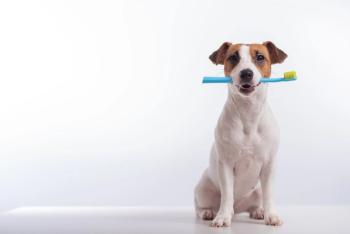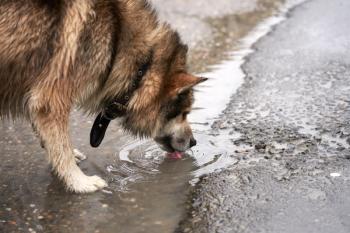
Presutures for skin stretching: Introduction (large photo)
Presutures are Lembert sutures placed in healthy skin on either side of a lesion. Placed several hours before the lesion is débrided or excised, these sutures stretch the skin around the lesion.
Presutures are Lembert sutures placed in healthy skin on either side of a lesion. Placed several hours before the lesion is débrided or excised, these sutures stretch the skin around the lesion. They are usually placed eight to 12 hours before wound closure. The sutures are typically indicated for limb wounds in which the edges cannot quite be initially apposed (see figure) or for the removal of lesions (tumors) on the limbs that will result in such a wound. The technique is indicated if, in the surgeon’s judgment, the wound will eventually close without the use of a graft or flap.1,2 If there is concern that the tension on the presutures might cut into underlying tissues (e.g. wound, tumor), you can place a primary bandage pad and some secondary padding over these tissues. In some instances, the use of presutures may not be advisable. For example, if pressure from the sutures might result in degranulation of a mast cell tumor, the procedure should probably not be used. If primary skin closure is not possible, open wound management or skin grafting is an option.
Presutures stretch skin to allow wound closure. They can be used alone or in conjunction with other tension-relieving techniques, such as an adjustable horizontal mattress suture or multiple punctate relaxing incisions, if the presutures alone do not provide sufficient relaxation. A disadvantage of presutures is that they may cause a biologic tourniquet—the skin may become circumferentially too tight. If this occurs, the tourniquet effect can be released by removing the sutures. If signs of impaired circulation occur, such as swelling and hypothermia of the digits, they are a warning that primary skin closure may not be possible and a graft or flap may be needed for reconstruction.
REFERENCES
1. Scardino MS, Swaim SF, Henderson RA , et al. Enhancing wound closure on the limbs. Compend Contin Educ Pract Vet 1996;18:919.
2. Swaim SF, Henderson RA . Small animal wound management. 2nd Ed. Baltimore, Md: Williams & Wilkins, 1997;173-175.
Editors’ Note:
This technique was demonstrated on a canine specimen obtained from a specimen supply company.
Acknowledgment
Thank you to Lori Lind, RVT, Gladstone Animal Clinic, Gladstone, Mo., for her assistance during the demonstration.
Steven F. Swaim, DVM, MS
Professor emeritus
Scott-Ritchey Research Center
Department of Clinical Sciences
College of Veterinary Medicine
Auburn University
Auburn University, AL 36849
<Step 6B
|
Step 1>
Introduction
Step 1
Step 3A
Step 4
Step 2
Step 6A
Step 6B
Step 5
Using presuturing to close distal limb wounds, video part 1
Using presuturing to close distal limb wounds, video part 2
Step by Step Article
Video of the procedure
Step 3B
Newsletter
From exam room tips to practice management insights, get trusted veterinary news delivered straight to your inbox—subscribe to dvm360.




